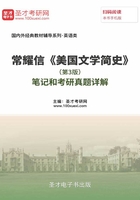
2.2 考研真题与典型题详解
I. Fill in the blanks.
1.In his ________ Benjamin Franklin creates the image of a boy’s rise from ________ to riches and demonstrates his belief that the new world of America was a land of opportunities which might be met through hard work and wise management.(天津外国语学院2008研)
【答案】Autobiography, poor
【解析】富兰克林在《自传》中讲述了其白手起家、自力更生的故事,平凡却生动的讲述表明他坚信通过努力就能实现美国梦。
2.If we say Jonathan Edwards represents the upper levels of the American mind, ________ represents the lower levels.
【答案】Benjamin Franklin
【解析】美国文学评论家范·威克·布鲁克斯(Van Wyck Brooks)在《美国的成年》(America’s Coming Age)中指出乔纳森·爱德华兹和本杰明·富兰克林是美国18世纪的两位重要的哲学家,他们是不同层次思想的代表。
3.Before his death, ________ had gained a position as America’s first systematic philosopher.
【答案】Jonathan Edwards
【解析】乔纳森·爱德华兹(1703-1758)是美国“大觉醒”(the “Great Awakening”)的领军人物,他生前赢得了“美国第一位系统的哲学家”称号。其著名作品是《意志自由》(Freedom of the Will)。
4.Jonathan Edwards’ work Images or Shadows of Divine Things anticipated the nature symbolism of ________ in the 19th century.
【答案】Transcendentalism
【解析】乔纳森·爱德华兹的作品《神灵的形影》(Images or Shadows of Divine Things)对19世纪的超验主义对象征主义的运用产生了很大的影响。
5.Franklin’s claim to a place in literature rests chiefly on his ________ and ________.
【答案】Poor Richard’s Almanac, Autobiography
【解析】富兰克林在文学上的地位主要取决于《穷查理历书》和《自传》。
6.Benjamin Franklin’s best writing is found in his masterpiece ________.
【答案】The Autobiography of Benjamin Franklin
【解析】本杰明·富兰克林文学上最大的成就体现在他的作品《本杰明·富兰克林自传》上。该书以平易的文风叙述了富兰克林艰苦创业、自学成才、坚持不懈的奋斗历程。
7.Franklin was the epitome of the________, the versatile,practical embodiment of national man in the l8th century.
【答案】Enlightenment
【解析】富兰克林是启蒙思想的缩影,是18世纪理性的代表。
8.Eighteen-century America experienced an age of________, of________, and ________ like England and Europe.
【答案】enlightenment, reason, order
【解析】18世纪的美国处于启蒙、理想、秩序的时代。
II. Multiple Choice.
1.The first symbol of self-made American man is ________.(北二外2009研)
A. George Washington
B. Washington Irving
C. Thomas Jefferson
D. Benjamin Franklin
【答案】D
【解析】富兰克林是第一个自力更生、白手起家的美国人的标志。
2.At the Reason and Revolution Period. Americans were influenced by the European movement called the________.
A. Charitist Movement
B. Romanticist Movement
C. Enlightenment Movement
D. Modernist Movement
【答案】C
【解析】欧洲的启蒙运动对美国理性和独立革命时期产生了深远影响。
3.In American literature, the eighteenth century was the age of the Enlightenment. ________ was the dominant spirit.
A. Humanism
B. Rationalism
C. Revolution
D. Evolution
【答案】B
【解析】启蒙运动通常是指在18世纪初至1789年法国大革命间的一个新思维不断涌现的时代,与理性主义等一起构成一个较长的文化运动时期,所以法国启蒙运动时期被称为“理性时代”。18世纪的美国同样受到启蒙思想的影响,因而理性主义是这个时期美国文学的主导思想。
4.Jonathan Edwards’ best and most representative sermon was ________.
A. A True Sight of Sin
B. Sinners in the Hands of an Angry God
C. A Model of Christian Charity
D. God’s Determinations
【答案】B
【解析】美国神学家乔纳森·爱德华兹最具代表性的布道是《愤怒的上帝手中之罪人》(Sinners in the Hands of an Angry God)。
5.The secular ideals of the American Enlightenment were exemplified in the life and career of ________.
A. Thomas Hood
B. Benjamin Franklin
C. Thomas Jefferson
D. George Washington
【答案】B
【解析】作为美国财富和智慧的象征,美国人民把富兰克林的头像印在100美元纸钞的正面。200多年来,这位智者的思想一直被那些希望拥有美德并过上富足生活的人们所遵循和实践着。他的个人生活和职业生涯代表了美国启蒙运动中世俗化的理想。
6.From 1732 to 1758, Benjamin Franklin wrote and published his famous ________, an annal collection of proverbs.
A. The Autobiography
B. Poor Richard’s Almanac
C. Common Sense
D. The General Magazine
【答案】B
【解析】《穷理查历书》(Poor Richard's Almanac)它是由美国资本主义精神最完美的代表——本杰明·富兰克林所写。该出版物从1732年至1758年不断出现。它幽默、睿智、形式奇特,通篇贯彻着人类的智慧精华,书中的名言警句与人生箴言即使在现在看来也具有很积极的作用。
III. Explain the following term.
1.the literary form of autobiography(北二外2008研)
Key: The literary form of autobiography: An autobiography is a person’s account of his or her life. It is generally written in the first person, with the author speaking as “I”. Autobiography presents life events as the writer views them, and offers insights into the beliefs and perceptions of the author. Representative writer: Benjamin Franklin and his work: The Autobiography.
IV. Essay questions
1.Analyze The Autobiography of Benjamin Franklin.
Key: The book is probably the first of its kind in literature. It is the simple yet immensely fascinating record of a man rising to wealth and fame from a state of poverty and obscurity in which he was born, the faithful account of the colorful career of America’s first self-made man. The book contains four parts, written at different times.
It is, first of all, a Puritan document. It is Puritan because it is a record of self-examination and self-improvement. It is also a convincing illustration of the Puritan ethic that in order to get on in the world, one has to be industrial, frugal, and prudent.
It is also an eloquent elucidation of the fact that Franklin was spokesman for the new order of the eighteenth-century enlightenment, and that he represented in America all its ideas, that man is basically good and free by nature, endowed by God with certain inalienable rights of liberty and the pursuit of happiness. Through telling a success story of self-reliance, the book celebrates, in fact, the fulfillment of the American dream.
The style of the book is the pattern of Puritan simplicity, directness, and concision. The lucidity of the narrative, the absence of ornaments in wording and complex, involved structures in syntax, and the Puritan abhorrence of paradox are all well graphically demonstrated here and in the whole of the book. Taken as a whole, it is safe to say that the book is an exemplary illustration of the American style of writing.
2.Analysis of The Poor Richard’s Almanac.
Key: Benjamin Franklin created a character, Poor Richard, in whose name the work appeared, and whose real existence was debated humorously and seriously. For almost a quarter of a century, he kept publishing Poor Richard’s Almanac, expanding its literary part to the intense delight of its readers.
Apart from poems and essays, he managed to put in a good many adages, and commonsense witticisms which became household words and many mottos of the most typical kind. He did not always write the maxims himself. He borrowed from others and made good use of his own wit and wisdom to simplify and enrich their axiom. There are many similar statements filled almanac, and taught as much as amused. The practical wisdom of Franklin shone forth rays of grandeur from its pages.